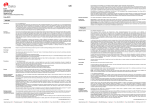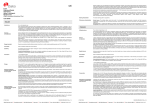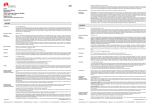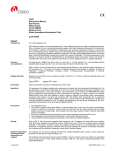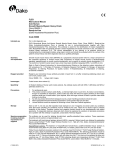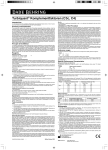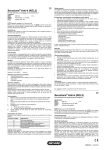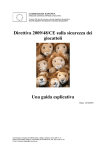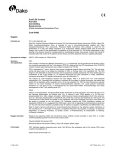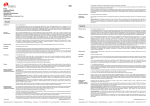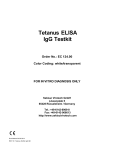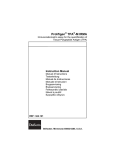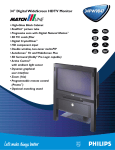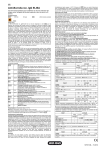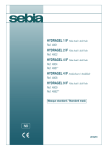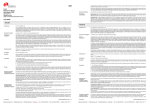Download FLEX Polyclonal Rabbit Anti-Human IgG Ready-to
Transcript
Counterstaining in hematoxylin is recommended using EnVision FLEX Hematoxylin (Dako Autostainer/Autostainer Plus) (Code K8018). Non-aqueous, permanent mounting medium is recommended. Positive and negative controls should be run simultaneously using the same protocol as the patient specimens. The positive control tissue should include tonsil and the cells/structures should display reaction patterns as described for this tissue in “Performance characteristics” in all positive specimens. The recommended negative control reagent is FLEX Negative Control, Rabbit (Dako Autostainer/Autostainer Plus) (Code IS600). FLEX Polyclonal Rabbit Anti-Human IgG Ready-to-Use (Dako Autostainer/Autostainer Plus) Staining interpretation The cellular staining pattern is cytoplasmic and/or cell membrane. Performance characteristics Normal tissues: Anti-IgG has been demonstrated to react with IgG on B-cells (7,8), in plasma cells in bone marrow (with infection present) (9), breast (10), salivary gland (11), and tonsil (beneath the crypt epithelium and in the follicle center) (11,12). IgG has also been found in plasmocytes of the appendix and tonsil (9), small intestines (13), and colon in small percentages (13). Abnormal tissues: In two studies investigating 33 (2) and 29 (3) paraffin-embedded tissues from cases of plasma cell neoplasia of various types, the labeling with the antibody showed a good correlation with the monoclonal immunoglobulin found in serum or urine. A clear distinction between reactive hyperplasia and monoclonal B-cell neoplasia was obtained when the antibody was used in combination with a panel of other antibodies to immunoglobulins (1), and particularly with antibodies to light chains (4). Code IS512 ENGLISH Intended use For in vitro diagnostic use. FLEX Polyclonal Rabbit Anti-Human IgG, Ready-to-Use, (Dako Autostainer/Autostainer Plus), is intended for use in immunohistochemistry together with Dako Autostainer/Autostainer Plus instruments. This antibody is useful for the identification of plasma cells and related lymphoid cells containing IgG, and it is a useful tool for the classification of patients with B-cell neoplasia (1-3). Additionally, the antibody may be used for distinguishing neoplastic monoclonal proliferation from reactive hyperplasia of plasma cells (1, 4). The clinical interpretation of any staining or its absence should be complemented by morphological studies using proper controls and should be evaluated within the context of the patient's clinical history and other diagnostic tests by a qualified pathologist. Summary and explanation The human immunoglobulins basically consist of two identical heavy chains (Mr about 50 000) and two identical light chains (Mr about 20 000). The four chains are covalently linked together by disulphide bonds. The light chains are either kappa or lambda. The five immunoglobulins, IgA, IgD, IgE, IgG and IgM, differ regarding the heavy chains, and IgA and IgM also occur in polymeric forms. The heavy chain of IgG is named the gamma-chain. In normal serum, IgG is the major immunoglobulin class constituting about 75% of the total immunoglobulin (5). The normal B-cell population is polyclonal and expresses a range of different immunoglobulin molecules. In contrast, a majority of B-cell neoplasias are characterized by the proliferation of monoclonal cells expressing only one type of light chain, whereas more than one heavy chain can be expressed by the same cell. The restricted expression of immunoglobulins by monoclonal B-cell lineage proliferations makes antibodies specific for immunoglobulin light- and heavy chains useful for the identification and isotyping of these neoplasias (6). Refer to Dako’s General Instructions for Immunohistochemical Staining or the detection system instructions of IHC procedures for: 1) Principle of Procedure, 2) Materials Required, Not Supplied, 3) Storage, 4) Specimen Preparation, 5) Staining Procedure, 6) Quality Control, 7) Troubleshooting, 8) Interpretation of Staining, 9) General Limitations. Reagent provided Ready-to-use polyclonal rabbit antibody provided in liquid form in a buffer containing stabilizing protein and 0.015 mol/L NaN3. Immunogen IgG isolated from a pool of normal human sera. Specificity The antibody reacts with the gamma-chains of human IgG. Traces of contaminating antibodies have been removed by solid-phase absorption. The specificity of the antibody has been ascertained as follows: Crossed immunoelectrophoresis: Only the IgG immunoprecipitation arch appears when using 12.5 µL concentrated antibody per cm2 gel area against 2 µL human plasma. Staining: Coomassie Brilliant Blue. ELISA: No significant reaction is seen in indirect ELISA using human IgA and IgM as coating antigens. In double antibody sandwich ELISA no significant reaction is observed with human plasma stripped of IgG. Precautions 1. For professional users. 2. This product contains sodium azide (NaN3), a chemical highly toxic in pure form. At product concentrations, though not classified as hazardous, sodium azide may react with lead and copper plumbing to form highly explosive build-ups of metal azides. Upon disposal, flush with large volumes of water to prevent metal azide build-up in plumbing. 3. As with any product derived from biological sources, proper handling procedures should be used. 4. Wear appropriate Personal Protective Equipment to avoid contact with eyes and skin. 5. Unused solution should be disposed of according to local, State and Federal regulations. Storage Store at 2-8 °C. Do not use after expiration date sta mped on vial. If reagents are stored under any conditions other than those specified, the conditions must be verified by the user. There are no obvious signs to indicate instability of this product. Therefore, positive and negative controls should be run simultaneously with patient specimens. If unexpected staining is observed which cannot be explained by variations in laboratory procedures and a problem with the antibody is suspected, contact Dako Technical Support. Specimen preparation including materials required but not supplied Staining procedure including materials required but not supplied The antibody can be used for labeling formalin-fixed, paraffin-embedded tissue sections. Tissue specimens should be cut into sections of approximately 4 µm. Pre-treatment with heat-induced epitope retrieval (HIER) is required using Dako PT Link (Code PT100/PT101). For details, please refer to the PT Link User Guide. Optimal results are obtained by pretreating tissues using EnVision FLEX Target Retrieval Solution, High pH (50x) (Code K8010/K8004). Paraffin-embedded sections: Pre-treatment of formalin-fixed, paraffin-embedded tissue sections is recommended using the 3-in-1 specimen preparation procedure for Dako PT Link. Follow the pre-treatment procedure outlined in the package insert for EnVision FLEX Target Retrieval Solution, High pH (50x) (Code K8010/K8004). Note: After staining the sections must be dehydrated, cleared and mounted using permanent mounting medium. Deparaffinized sections: Pre-treatment of deparaffinized formalin-fixed, paraffin-embedded tissue sections is recommended using Dako PT Link and following the same procedure as described for paraffin-embedded sections. After staining the slides should be mounted using aqueous or permanent mounting medium. The tissue sections should not dry out during the treatment or during the following immunohistochemical staining procedure. For greater adherence of tissue sections to glass slides, the use of FLEX IHC Microscope Slides (Code K8020) is recommended. FRANÇAIS Utilisation prévue Pour utilisation diagnostique in vitro. FLEX Polyclonal Rabbit Anti-Human IgG, Ready-to-Use, (Dako Autostainer/Autostainer Plus) est destiné à une utilisation en immunohistochimie avec les instruments Dako Autostainer/Autostainer Plus. Cet anticorps facilite l’identification des cellules plasmatiques et des cellules lymphoïdes associées contenant des IgG, et s’avère utile dans la classification des patients présentant des néoplasies à lymphocytes B (1–3). De plus, cet anticorps peut être utilisé pour différencier une prolifération monoclonale néoplasique d’une hyperplasie réactive des cellules plasmatiques (1, 4). L’interprétation clinique de toute coloration ou son absence doit être complétée par des études morphologiques en utilisant des contrôles appropriés et doit être évaluée en fonction des antécédents cliniques du patient et d’autres tests diagnostiques par un pathologiste qualifié. Résumé et explication La structure de base des immunoglobulines humaines comprend deux chaînes lourdes identiques (poids moléculaire d’environ 50 000) et deux chaînes légères identiques (poids moléculaire d’environ 20 000). Ces quatre chaînes sont liées entre elles par des liaisons covalentes grâce à des ponts disulfures. Il y a deux types de chaînes légères : kappa ou lambda. Les cinq classes d’immunoglobulines, IgA, IgD, IgE, IgG et IgM, se différencient par leurs chaînes lourdes. Les IgA et IgM sont aussi présentes sous forme polymérique. La chaîne lourde d’IgG est appelée chaîne gamma. Dans le sérum normal, les IgG constituent la principale classe d’immunoglobulines, soit environ 75 % des immunoglobulines totales (5). La population de lymphocytes B normaux est polyclonale et exprime un grand nombre de molécules d’immunoglobulines différentes. En revanche, une majorité de néoplasies à lymphocytes B est caractérisée par la prolifération de cellules monoclonales exprimant un seul type de chaîne légère, alors que plusieurs chaînes lourdes peuvent être exprimées par la même cellule. L’expression restreinte des immunoglobulines par les proliférations de lignées cellulaires B monoclonales rend les anticorps spécifiques aux chaînes légères et lourdes d’immunoglobulines utiles pour l’identification et l’isotypage de ces néoplasies (6). Se référer aux Instructions générales de coloration immunohistochimique de Dako ou aux instructions du système de détection relatives aux procédures IHC pour plus d’informations concernant les points suivants : 1) Principe de procédure, 2) Matériels requis mais non fournis, 3) Conservation, 4) Préparation des échantillons, 5) Procédure de coloration, 6) Contrôle qualité, 7) Dépannage, 8) Interprétation de la coloration, 9) Limites générales. Réactifs fournis Anticorps polyclonal de lapin prêt à l’emploi fourni sous forme liquide dans un tampon contenant une protéine stabilisante et 0,015 mol/L d’azide de sodium. Immunogène IgG isolée à partir d’un pool d’échantillons de sérum humain normal Spécificité L’anticorps réagit aux chaînes gamma des IgG humaines. Les traces d’anticorps contaminants ont été supprimées par absorption en phase solide. La spécificité de l’anticorps a été établie comme suit : Immunoélectrophorèse croisée : Seul l’arc d’immunoprécipitation des IgG apparaît lorsqu’on utilise 12,5 µL d’anticorps concentré par cm² de gel contre 2 µL de plasma humain. Coloration : Bleu de Coomassie. ELISA : Aucune réaction significative n’est observée dans les tests ELISA indirects utilisant des IgG et des IgM humaines comme antigènes de surface. Lors d’un test ELISA sandwich, aucune réaction significative n'a été observée avec le plasma humain lavé des IgG. Précautions 1. Pour utilisateurs professionnels. 2. Ce produit contient de l’azide de sodium (NaN3), produit chimique hautement toxique dans sa forme pure. Aux concentrations du produit, bien que non classé comme dangereux, l’azide de sodium peut réagir avec le cuivre et le plomb des canalisations et former des accumulations d’azides métalliques hautement explosifs. Lors de l’élimination, rincer abondamment à l’eau pour éviter toute accumulation d’azide métallique dans les canalisations. 3. Comme avec tout produit d’origine biologique, des procédures de manipulation appropriées doivent être respectées. 4. Porter un vêtement de protection approprié pour éviter le contact avec les yeux et la peau. 5. Les solutions non utilisées doivent être éliminées conformément aux réglementations locales et nationales. Conservation Conserver entre 2 et 8 °C. Ne pas utiliser après la date de péremption indiquée sur le flacon. Si les réactifs sont conservés dans des conditions autres que celles indiquées, celles-ci doivent être validées par l’utilisateur. Il n’y a aucun signe évident indiquant l’instabilité de ce produit. Par conséquent, des contrôles positifs et négatifs doivent être testés en même temps que les échantillons de patient. Si une coloration inattendue est observée, qui ne peut être expliquée par un changement des procédures du laboratoire, et en cas de suspicion d’un problème lié à l’anticorps, contacter l’assistance technique de Dako. Préparation des échantillons y compris le matériel requis mais non fourni L’anticorps peut être utilisé pour le marquage des coupes de tissus inclus en paraffine et fixés au formol. L’épaisseur des coupes d’échantillons de tissu doit être d’environ 4 µm. Un prétraitement avec démasquage d’épitope induit par la chaleur (HIER) est nécessaire avec le Dako PT Link (Réf. PT100/PT101). Pour plus de détails, se référer au Guide d’utilisation du PT Link. Des résultats optimaux sont obtenus en prétraitant les tissus à l’aide de la EnVision FLEX Target Retrieval Solution, High pH (50x) (Réf. K8010/K8004). Coupes incluses en paraffine : le prétraitement des coupes tissulaires fixées au formol et incluses en paraffine est recommandé à l'aide de la procédure de préparation d'échantillon 3-en-un pour le Dako PT Link. Suivre la procédure de prétraitement indiquée dans la notice de la EnVision FLEX Target Retrieval Solution, High pH (50x) (Réf. K8010/K8004). Remarque : après coloration, les coupes doivent être déshydratées, lavées et montées à l’aide d’un milieu de montage permanent. Coupes déparaffinées : le prétraitement des coupes tissulaires déparaffinées, fixées au formol et incluses en paraffine, est recommandé à l’aide du Dako PT Link, en suivant la même procédure que pour les coupes incluses en paraffine. Après coloration, un montage aqueux ou permanent des lames est recommandé. Les coupes de tissus ne doivent pas sécher lors du traitement ni lors de la procédure de coloration immunohistochimique suivante. Pour une meilleure adhérence des coupes de tissus sur les lames de verre, il est recommandé d’utiliser des lames FLEX IHC Microscope Slides (Réf. K8020). The recommended visualization system is EnVision FLEX, High pH (Dako Autostainer/Autostainer Plus) (Code K8010). The staining steps and incubation times are pre-programmed into the software of Dako Autostainer/Autostainer Plus instruments, using the following protocols: Template protocol: FLEXRTU2 (200 µL dispense volume) or FLEXRTU3 (300 µL dispense volume) Autoprogram: IgG (without counterstaining) or IgGH (with counterstaining) The Auxiliary step should be set to “rinse buffer” in staining runs with ≤10 slides. For staining runs with >10 slides the Auxiliary step should be set to “none”. This ascertains comparable wash times. All incubation steps should be performed at room temperature. For details, please refer to the Operator’s Manual for the dedicated instrument. If the protocols are not available on the used Dako Autostainer platform, please contact Dako Technical Services. Optimal conditions may vary depending on specimen and preparation methods, and should be determined by each individual laboratory. If the evaluating pathologist should desire a different staining intensity, a Dako Application Specialist/Technical Service Specialist can be contacted for information on re-programming of the protocol. Verify that the performance of the adjusted protocol is still valid by evaluating that the staining pattern is identical to the staining pattern described in “Performance characteristics”. (115309-002) Dako Denmark A/S IS512/EFG/MNI/2009.12.04 p. 1/4 | Produktionsvej 42 | DK-2600 Glostrup | Denmark | Tel. +45 44 85 95 00 | Fax +45 44 85 95 95 | CVR No. 33 21 13 17 (115309-002) Dako Denmark A/S IS512/EFG/MNI/2009.12.04 p. 2/4 | Produktionsvej 42 | DK-2600 Glostrup | Denmark | Tel. +45 44 85 95 00 | Fax +45 44 85 95 95 | CVR No. 33 21 13 17 Procédure de coloration y compris le matériel requis mais non fourni Target Retrieval Solution, High pH (50x) (Code-Nr. K8010/K8004) erzielt werden. Paraffineingebettete Schnitte: Die Vorbehandlung der formalinfixierten, paraffineingebetteten Schnitte mit dem 3-in-1Probenvorbereitungsverfahren für Dako PT Link wird empfohlen. Vorbehandlung gemäß der Beschreibung in der Packungsbeilage für EnVision FLEX Target Retrieval Solution, High pH (50x) (Code-Nr. K8010/K8004) durchführen. Hinweis: Nach dem Färben müssen die Schnitte dehydriert, geklärt und mit permanentem Einbettmedium auf den Objektträger aufgebracht werden. Entparaffinierte Schnitte: Eine Vorbehandlung der entparaffinierten, formalinfixierten, paraffineingebetteten Gewebeschnitte mit Dako PT Link nach demselben Verfahren, wie für die paraffineingebetteten Schnitte beschrieben, wird empfohlen. Die Objektträger nach dem Färben mit einem wässrigen oder permanenten Einbettmedium bedecken. Die Gewebeschnitte dürfen während der Behandlung oder des anschließenden immunhistochemischen Färbeverfahrens nicht austrocknen. Zur besseren Haftung der Gewebeschnitte an den Glasobjektträgern wird die Verwendung von FLEX IHC Microscope Slides (Code-Nr. K8020) empfohlen. Le système de visualisation recommandé est le EnVision FLEX, High pH (Dako Autostainer/Autostainer Plus) (Réf. K8010). Les étapes de coloration et les temps d’incubation sont préprogrammés dans le logiciel des instruments Dako Autostainer/Autostainer Plus, à l’aide des protocoles suivants : Protocole modèle : FLEXRTU2 (volume de distribution de 200 µL) ou FLEXRTU3 (volume de distribution de 300 µL) Autoprogram : IgG (sans contre-coloration) ou IgGH (avec contre-coloration) L’étape Auxiliary doit être réglée sur « rinse buffer » lors des cycles de coloration avec ≤10 lames. Pour les cycles de coloration de >10 lames, l’étape Auxiliary doit être réglée sur « none ». Cela garantit des temps de lavage comparables. Toutes les étapes d’incubation doivent être effectuées à température ambiante. Pour plus de détails, se référer au Manuel de l’opérateur spécifique à l'instrument. Si les protocoles ne sont pas disponibles sur la plateforme Dako Autostainer utilisée, contacter le service technique de Dako. Les conditions optimales peuvent varier en fonction du prélèvement et des méthodes de préparation, et doivent être déterminées par chaque laboratoire individuellement. Si le pathologiste qui réalise l’évaluation désire une intensité de coloration différente, un spécialiste d’application/spécialiste du service technique de Dako peut être contacté pour obtenir des informations sur la re-programmation du protocole. Vérifier que l'exécution du protocole modifié est toujours valide en vérifiant que le schéma de coloration est identique au schéma de coloration décrit dans les « Caractéristiques de performance ». Il est recommandé d’effectuer une contre-coloration à l’aide de EnVision™ FLEX Hematoxylin (Dako Autostainer/Autostainer Plus) (Réf. K8018). L’utilisation d’un milieu de montage permanent non aqueux est recommandée. Des contrôles positifs et négatifs doivent être réalisés en même temps et avec le même protocole que les échantillons du patient. Le contrôle de tissu positif doit comprendre l’amygdale et les cellules/structures doivent présenter des schémas de réaction tels que décrits pour ces tissus dans les « Caractéristiques de performance » pour tous les échantillons positifs. Le contrôle négatif recommandé est le FLEX Negative Control, Rabbit, (Dako Autostainer/Autostainer Plus) (Réf. IS600). Interprétation de la coloration Le schéma de coloration cellulaire est cytoplasmique et/ou membranaire. Caractéristiques de performance Tissus sains : L’anti-IgG a présenté une réaction aux IgG sur les lymphocytes B (7, 8), les cellules plasmatiques de la moelle osseuse (dans les cas d’infection) (9) le sein (10), la glande salivaire (11), et l’amygdale (entre l'épithélium cryptique et le centre folliculaire) (11, 12). Les IgG sont également présentes dans les plasmocytes de l’appendice et de l’amygdale (9), de l’intestin grêle (13), et du côlon en faibles pourcentages (13). Tissus tumoraux : Dans deux études portant sur 33 (2) et 29 (3) tissus inclus en paraffine provenant de cas de néoplasie cellulaire plasmatique de divers types, le marquage par l’anticorps a présenté une forte corrélation avec l’immunoglobuline monoclonale retrouvée dans le sérum ou les urines. Une nette distinction entre hyperplasie réactive et néoplasie à lymphocytes B monoclonale a été obtenue lorsque l’anticorps a été utilisé en association avec un panel d’autres anticorps dirigés contre des immunoglobulines (1), et en particulier avec des anticorps dirigés contre des chaînes légères (4). DEUTSCH Zweckbestimmung Zur In-vitro-Diagnostik. FLEX Polyclonal Rabbit Anti-Human IgG, Ready-to-Use, (Dako Autostainer/Autostainer Plus) ist zur Verwendung in der Immunhistochemie in Verbindung mit Dako Autostainer/Autostainer Plus-Geräten bestimmt. Dieser Antikörper dient zur Erkennung von Plasmazellen und damit in Zusammenhang stehenden Lymphoidzellen mit IgG und hat sich für die Klassifizierung von Patienten mit B-Zell-Neoplasien als nützlich erwiesen (1–3). Außerdem ermöglicht der Antikörper eine Differenzierung zwischen neoplastischer monoklonaler Proliferation und reaktiver Hyperplasie von Plasmazellen (1, 4). Die klinische Auswertung einer eventuell eintretenden Färbung sollte durch morphologische Studien mit geeigneten Kontrollen ergänzt werden und von einem qualifizierten Pathologen unter Berücksichtigung der Krankengeschichte und anderer diagnostischer Tests des Patienten vorgenommen werden. Zusammenfassung und Erklärung Die menschlichen Immunglobuline bestehen im Prinzip aus zwei identischen H-Ketten (Mr ca. 50.000) und zwei identischen L-Ketten (Mr ca. 20.000). Die vier Ketten sind über Disulfidverbindungen kovalent miteinander verbunden. Bei den L-Ketten handelt es sich entweder um Ketten des Kappa- oder des Lambda-Typs. Die fünf Immunglobuline IgA, IgD, IgE, IgG und IgM unterscheiden sich hinsichtlich der H-Ketten. IgA und IgM treten auch in polymeren Formen auf. Die H-Kette von IgG wird als Gamma-Kette bezeichnet. In gesundem Serum ist IgG die vorherrschende Immunglobulinklasse mit rund 75 % Anteil am Immunglobulin insgesamt (5). Die gesunde B-Zellenpopulation ist polyklonal und exprimiert eine reihe unterschiedlicher Immunglobulinmoleküle. Dagegen zeichnet sich ein Großteil der B-Zellen-Neoplasmen durch eine Proliferation monoklonaler Zellen aus, die nur einen L-Kettentyp, jedoch mehr als einen H-Kettentyp exprimieren können. Durch die eingeschränkte Expression von Immunglobulinen durch geradlinige Proliferationen monoklonaler B-Zellen ist der Antikörper spezifisch für L- und H-Ketten des Immunglobulins und somit nützlich zur Erkennung und Isotypisierung dieser Neoplasmen (6). Folgende Angaben bitte den Allgemeinen Richtlinien zur immunhistochemischen Färbung von Dako oder den Anweisungen des Detektionssystems für IHC-Verfahren entnehmen: 1) Verfahrensprinzip, 2) Erforderliche, aber nicht mitgelieferte Materialien, 3) Aufbewahrung, 4) Vorbereitung der Probe, 5) Färbeverfahren, 6) Qualitätskontrolle, 7) Fehlersuche und -behebung, 8) Auswertung der Färbung, 9) Allgemeine Beschränkungen. Färbeverfahren und erforderliche, aber nicht mitgelieferte Materialien Das empfohlene Visualisierungssystem ist EnVision™ FLEX, High pH, (Dako Autostainer/Autostainer Plus) (Code-Nr. K8010). Die Färbeschritte und Inkubationszeiten sind in der Software der Dako Autostainer/Autostainer Plus-Geräte mit den folgenden Protokollen vorprogrammiert: Matrix-Protokoll: FLEXRTU2 (200 µL Abgabevolumen) oder FLEXRTU3 (300 µL Abgabevolumen) Autoprogram: IgG (ohne Gegenfärbung) oder IgGH (mit Gegenfärbung) Bei Färbedurchläufen mit höchstens 10 Objektträgern sollte der „Zusatz“-Schritt auf „Pufferspülgang“ eingestellt werden. Für Färbedurchläufe mit mehr als 10 Objektträgern den „Zusatz“-Schritt auf „Keine“ einstellen. Dieses gewährleistet vergleichbare Waschzeiten. Alle Inkubationsschritte sollten bei Raumtemperatur durchgeführt werden. Nähere Einzelheiten bitte dem Benutzerhandbuch für das jeweilige Gerät entnehmen. Wenn die Färbeprotokolle auf dem verwendeten Dako Autostainer-Gerät nicht verfügbar sind, bitte den Technischen Kundendienst von Dako verständigen. Optimale Bedingungen können je nach Probe und Präparationsverfahren unterschiedlich sein und sollten vom jeweiligen Labor selbst ermittelt werden. Falls der beurteilende Pathologe eine andere Färbungsintensität wünscht, kann ein Anwendungsspezialist oder Kundendiensttechniker von Dako bei der Neuprogrammierung des Protokolls helfen. Die Leistung des angepassten Protokolls muss verifiziert werden, indem gewährleistet wird, dass das Färbemuster mit dem unter „Leistungsmerkmale“ beschriebenen Färbemuster identisch ist. Die Gegenfärbung in Hämatoxylin sollte mit EnVision™ FLEX Hematoxylin, (Dako Autostainer/Autostainer Plus) (Code-Nr. K8018) ausgeführt werden. Empfohlen wird ein nichtwässriges, permanentes Fixiermittel. Positiv- und Negativkontrollen sollten zur gleichen Zeit und mit demselben Protokoll wie die Patientenproben getestet werden. Das positive Kontrollgewebe sollte Mandelgewebe enthalten und die Zellen/Strukturen müssen in allen positiven Proben die für dieses Gewebe unter „Leistungsmerkmale“ beschriebenen Reaktionsmuster aufweisen. Das empfohlene negative Kontrollreagenz ist FLEX Negative Control, Rabbit (Dako Autostainer/Autostainer Plus) (Code-Nr. IS600). Auswertung der Färbung Das zelluläre Färbemuster ist zytoplasmatisch und/oder membranös. Leistungsmerkmale Gesundes Gewebe: Anti-IgG hat nachweislich mit IgG auf B-Zellen (7, 8) in Plasmazellen des Knochenmarks (bei Vorliegen einer Infektion) (9), Brust (10), Speicheldrüsen (11) und Mandelgewebe (unterhalb des Kryptenepithels und im Follikelzentrum) reagiert (11, 12). Geringe prozentuale Anteile von IgG wurden in den Plasmozyten des Appendix und der Mandeln (9), im Dünndarm (13) und im Darm nachgewiesen (13). Pathologisches Gewebe: In zwei Studien wurden 33 (2) und 29 (3) paraffineingebettete Gewebeschnitte untersucht, die von Fällen von Plasmaneoplasien unterschiedlicher Typen gewonnen worden waren. Die Markierung mit dem Antikörper zeigte eine ausgeprägte Korrelation mit dem monoklonalen Immunglobulin, das im Serum oder Urin nachgewiesen worden war. Eine deutliche Differenzierung zwischen reaktiver Hyperplasie und monoklonaler B-Zell-Neoplasie wurde erhalten, wenn der Antikörper zusammen mit einem Panel weiterer Antikörper gegen Immunglobuline (1) eingesetzt wurde. Dies traf insbesondere auf Antikörper mit L-Ketten zu (4). References/ Références/ Literatur 1. Taylor CR, Burns J. The demonstration of plasma cells and other immunoglobulin-containing cells in formalin-fixed, paraffin-embedded tissues using peroxidase-labelled antibody. J Clin Pathol 1974;27:14-20. 2. Taylor CR, Mason DY. The immunohistological detection of intracellular immunoglobulin in formalin-paraffin sections from multiple myeloma and related conditions using the immunoperoxidase technique. Clin exp Immunol 1974;18:417-29. 3. Taylor CR, Russell R, Chandor S. An immunohistologic study of multiple myeloma and related conditions, using an immunoperoxidase method. Am J Clin Pathol 1978;70:612-22. 4. Beschorner R, Horny H-P, Petrusch UR, Kaiserling E. Frequent expression of haemopoietic and non-haemopoietic antigens by reactive plasma cells: an immunohistochemical study using formalin-fixed, paraffin-embedded tissue. Histol Histopathol 1999;14:805-12. 5. Klein J, Hořejši V. Immunology. 2nd ed. Abingdon (UK): Blackwell Science Ltd; 1999. p. 226-7, 238-46. 6. Leong ASY, Cooper K, Leong FJWA. Manual of diagnostic antibodies for immunohistology. London: Oxford University Press; 1999. p. 217-9. 7. Nadji M, Morales AR. Immunoperoxidase techniques, a practical approach to tumor Diagnosis. Chicago: American Society of Clinical Pathologists Press 1986; 11 Gebrauchsfertiger polyklonaler Kaninchen-Antikörper in flüssiger Form in einem Puffer, der stabilisierendes Protein und 0,015 mol/L NaN3 enthält. 8. Boenisch T, Farmilo AJ, Stead RH. Handbook: Immunochemical Staining Methods. 3rd Edition. DakoCytomation 2001. Immunogen Aus gepooltem gesundem Humanserum isoliertes IgG. 9. Stul MS, Logghe GN, Bergmans GB, Vanvuchelen JK, Louwagie AC. Discordances of cytoplasmic immunoglobulin G staining with the immunoperoxidase technic in plasma cells from bone marrow, tonsils and appendix. Amer J Clin Pathol 1985; 83(6):725. Spezifität Der Antikörper reagiert mit den Gamma-Ketten des humanen IgG. Spuren von Verunreinigungen durch Antikörper wurden durch FestphasenAbsorption entfernt. Die Spezifität dieses Antikörpers wurde wie folgt ermittelt: 2 Gekreuzte Immunelektrophorese: Bei Verwendung von 12,5 µL konzentriertem Antikörper pro cm Gelfläche gegen 2 µL Humanplasma erscheint nur die halbmondförmige IgG-Immunpräzipitatlinie. Färbung: Coomassie Brilliant Blue. ELISA: Im indirekten ELISA wurde bei Nutzung von humanem IgA und IgM als Coating-Antigene keine signifikante Reaktion festgestellt. Beim Doppelantikörper-Sandwich-ELISA wurde bei Humanplasma, das frei von IgG war, keine signifikante Reaktion beobachtet. Geliefertes Reagenz Vorsichtsmaßnahmen 1. Nur für Fachpersonal bestimmt. 2. Dieses Produkt enthält Natriumazid (NaN3), eine in reiner Form äußerst giftige Chemikalie. Natriumazid kann auch in als ungefährlich eingestuften Konzentrationen mit Blei- und Kupferrohren reagieren und hochexplosive Metallazide bilden. Nach der Entsorgung stets mit viel Wasser nachspülen, um Metallazidansammlungen in den Leitungen vorzubeugen. 3. Wie alle Produkte biologischen Ursprungs müssen auch diese entsprechend gehandhabt werden. 4. Geeignete Schutzkleidung tragen, um Augen- und Hautkontakt zu vermeiden. 5. Nicht verwendete Lösung ist entsprechend örtlichen, bundesstaatlichen und staatlichen Richtlinien zu entsorgen. Lagerung 12. Curran RC, Jones EL. Immunoglobulin-containing cells in human tonsils as demonstrated by immuno-histochemistry. Clin Exp Immunol 1977; 28:103. 13. Brandtzaeg P, Baklien K. Immunoglobulin-producing cells in the intestine in health and disease. Clin Gastroenterol 1976; 5(2):251. Explanation of symbols/ Explication des symboles/ Erläuterung der Symbole Bei 2–8 °C aufbewahren. Nach Ablauf des auf dem Fläschch en aufgedruckten Verfalldatums nicht mehr verwenden. Werden die Reagenzien unter anderen als den angegebenen Bedingungen aufbewahrt, müssen diese Bedingungen vom Benutzer validiert werden. Es gibt keine offensichtlichen Anzeichen für eine eventuelle Produktinstabilität. Positiv- und Negativkontrollen sollten daher zur gleichen Zeit wie die Patientenproben getestet werden. Falls es zu einer unerwarteten Färbung kommt, die sich nicht durch Unterschiede bei Laborverfahren erklären lässt und auf ein Problem mit dem Antikörper hindeutet, ist der technische Kundendienst von Dako zu verständigen. Vorbereitung der Probe und erforderliche, aber nicht mitgelieferte Materialien (115309-002) Dako Denmark A/S 10. Hsu S-M, Hsu P-L, Nayak RN. Warthin’s tumor: An immunohistochemical study of its lymphoid stroma. Human Pathol 1981; 12(3):251. 11. Curran RC, Gregory J. Demonstration of immunoglobulin in cryostat and paraffin sections of human tonsil by immunofluorescence and immunoperoxidase techniques: Effects of processing on immunohistochemical performance of tissues and on the use of proteolytic enzymes to unmask antigens in sections. J Clin Pathol 1978; 31:974. Der Antikörper eignet sich zur Markierung von formalinfixierten und paraffineingebetteten Gewebeschnitten. Gewebeproben sollten in Schnitte von ca. 4 µm Stärke geschnitten werden. Die Vorbehandlung durch hitzeinduzierte Epitopdemaskierung (HIER) mit Dako PT Link (Code-Nr. PT100/PT101) ist erforderlich. Weitere Informationen hierzu siehe PT Link-Benutzerhandbuch. Optimale Ergebnisse können durch Vorbehandlung der Gewebe mit EnVision FLEX IS512/EFG/MNI/2009.12.04 p. 3/4 | Produktionsvej 42 | DK-2600 Glostrup | Denmark | Tel. +45 44 85 95 00 | Fax +45 44 85 95 95 | CVR No. 33 21 13 17 Catalogue number Référence catalogue Bestellnummer Temperature limitation Limites de température Use by Utiliser avant Zulässiger Temperaturbereich Verwendbar bis In vitro diagnostic medical device Dispositif médical de diagnostic in vitro In-vitro-Diagnostikum Contains sufficient for <n> tests Contenu suffisant pour <n> tests Manufacturer Fabricant Inhalt ausreichend für <n> Tests Hersteller Consult instructions for use Voir les instructions d’utilisation Gebrauchsanweisung beachten Batch code Numéro de lot (115309-002) Dako Denmark A/S Chargenbezeichnung IS512/EFG/MNI/2009.12.04 p. 4/4 | Produktionsvej 42 | DK-2600 Glostrup | Denmark | Tel. +45 44 85 95 00 | Fax +45 44 85 95 95 | CVR No. 33 21 13 17


